Milestones
“The only country where socialism stands a chance is the USA because it’s the only country that can’t be invaded by the USA.” – a meme circulating on social media
“People don’t hibernate ever!” – a boy in Milestones
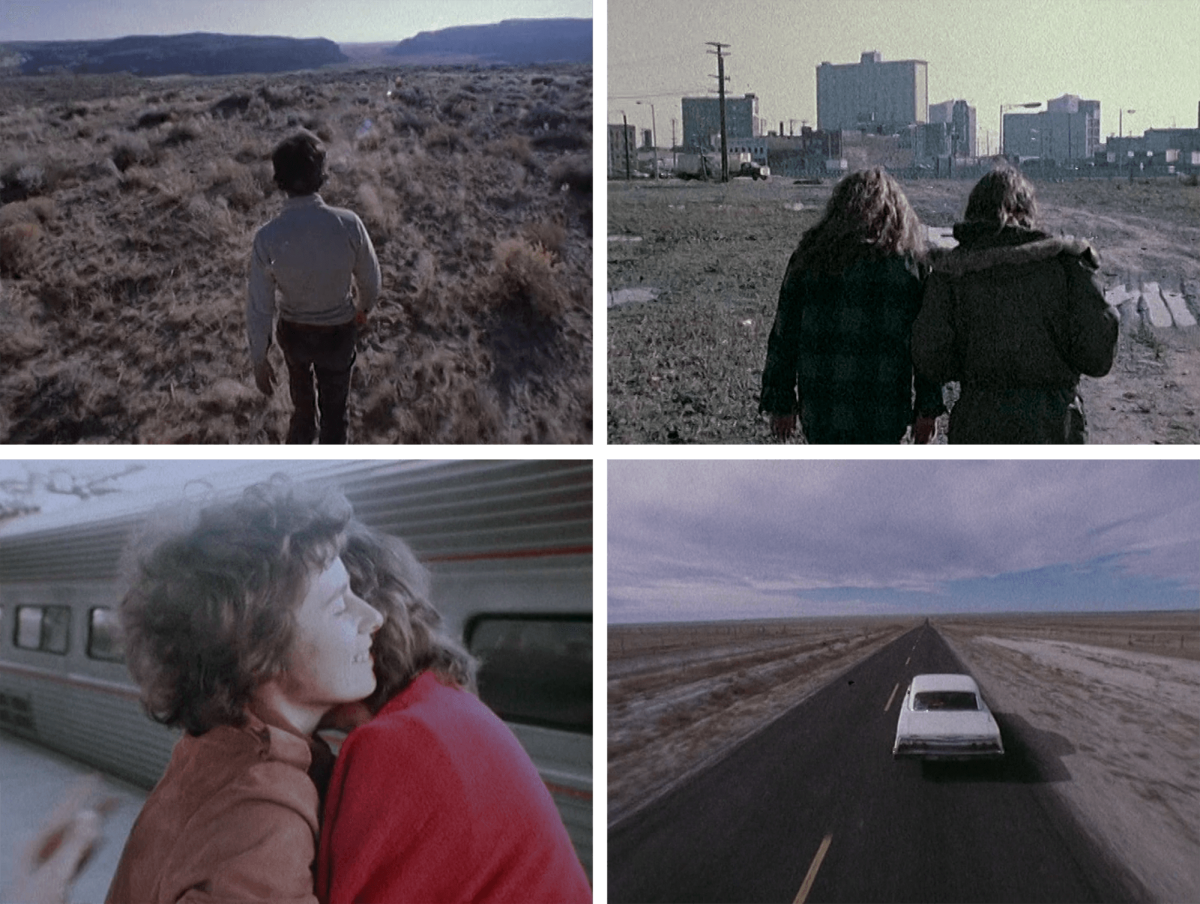
In Robert Kramer’s Ice (1970), a fictional armed uprising takes place on American soil. While the US is waging an imperialist war in Mexico, several revolutionary cells organize an offensive in the cities. In the middle of the violent events, one of the leaders puts the ineluctable chain of actions and reactions occupying his body and mind into resigned words. He is surrounded by a vast snowy landscape, and it is unclear whether he is stealthily addressing the viewer or a fellow combatant off-screen.
“What we have here is a situation where we find ourselves in the midst of a river with very strong currents and with no way of getting out of the river, but that’s not bad. And you just go ahead and do what you can’t avoid doing. And your mind follows along. So, you’ve got to change your mind around, […] no need to even ask some of those questions you used to be asking… Interesting to think of the ideas being not your ideas but being part of a movement… What do you make of that? A little crazy?”
Four years later, in Milestones (1975), Kramer and John Douglas capture a pivotal time in the life of a group of left-wing militants, to which they also belong themselves. The film struggles with what comes after the wild river has branched off and the characters have drifted onto different slower side streams, with others having reached the riverbanks or drowned. Their earlier, shared political horizon is not as clearly visible anymore. The end of the Vietnam War marks a caesura, along with the disintegration of the civil rights movement, the awakening from the dream of May ’68 and the subsequent consolidation of a global conservative hegemony. There is a renewed need to ask questions and formulate one’s own ideas. The concrete meaning of being leftist is radically changing. A few years earlier, the work consisted mainly of organizing protests, local occupations, mobilizing workers within trade unions, reinforcing class consciousness, producing and distributing propaganda, breaking into the existing media by means of controversial and spectacular actions, coordinating and perpetuating solidarity with groups such as the Black Panthers and indigenous protest movements, international collaborations, or helping conscientious objectors and deserters go underground. The urgencies that dominated the lives of these militants can no longer be translated into concrete revolutionary work, although they are still as urgent as ever. Paths part and meet in various attempts to relate to the changed political reality. Not the unconditionality, but the immediacy or speed with which they mobilized their bodies and minds has disappeared. Scattered across the vast landscapes of the US, they are working out how – in the meantime? – to live with each other and with themselves, how to reinvent their resistance. Being leftist means something else now, but what? Milestones shows the death struggle of one political subject during the birth of another.
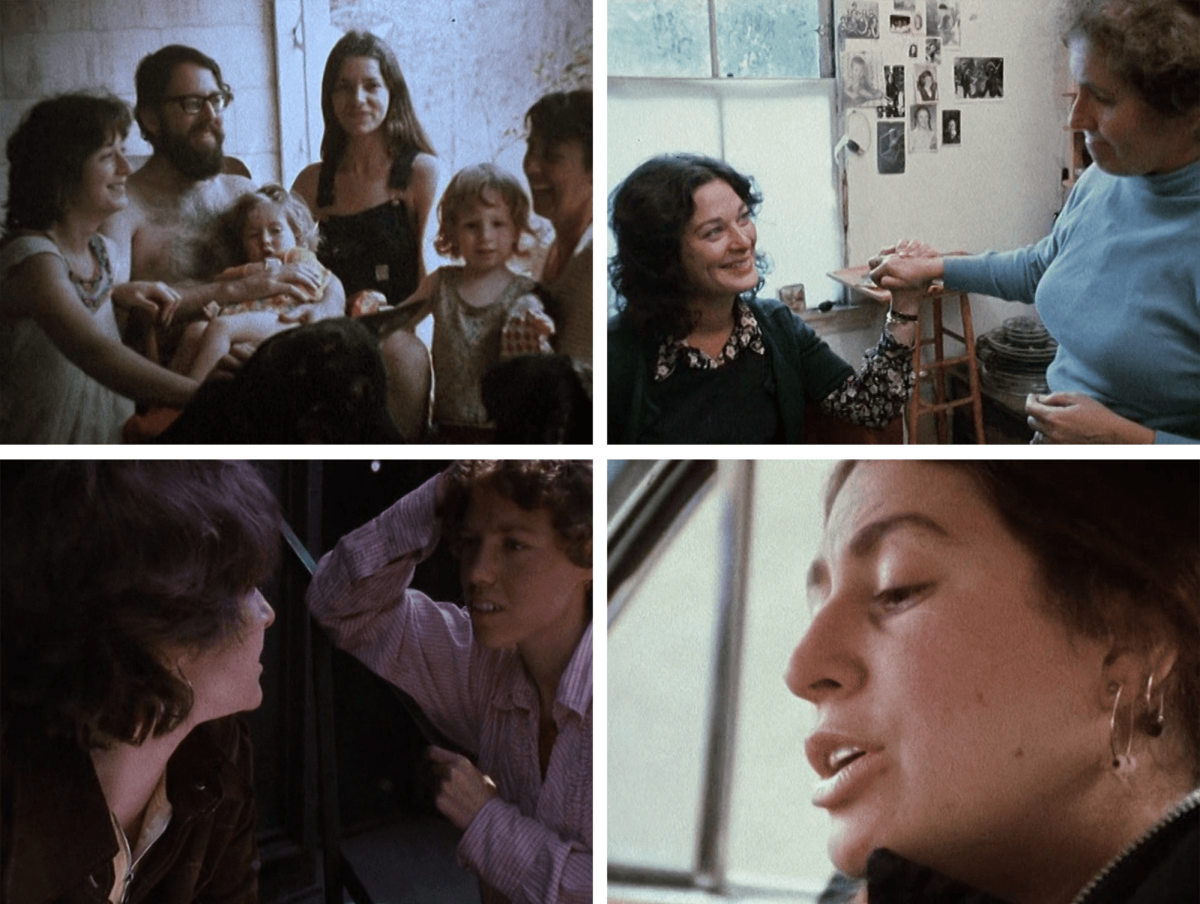
“What makes a tribe?”
This revolution is reflected in the film’s form. The film marks a hinge in Kramer’s oeuvre, both formally and politically. Kramer aims to look himself and his contemporaries in the eye and see what went wrong. Along with this introspection, his way of filming and editing changes. The militant documentaries made by Kramer and the Newsreel collective – for example, among the Viet Cong fighters during the Vietnam War – make up Kramer’s own wild river. Characteristic of these films as well as his fiction films of the time is their pursuit of a certain ugliness. Carelessness with regard to the aesthetic quality of images was supposed to produce a reality effect. The real underground image is jerky and raw. This antiaestheticism does not, however, prove to be a lasting, subversive antispectacle, but is quickly swallowed by the spectacle itself – both within the films’ narrative logic and outside, as a spearhead in the mass-media machinery. This “authenticating” ugly camerawork is still standard repertoire for many journalists and filmmakers today. The strategy of the absent form as a form, the suspension of aesthetic space, creates an illusion of immediacy and truthfulness. But the mannerism can only feign its absence here. Paradoxically, “direct” contact with reality emphasizes the ideological workings of journalism, the spectacle of defying reality, the journalists themselves. While for Kramer and the Newsreel collective it still implied a less mediated, unpolished contact with proletarian reality – a formal gesture towards the outside world – it has become a rather narcissistic ugliness today. While, at first sight, it seems to mean “we were really there,” it actually says, “we were really there.” In a certain sense, Milestones tries to emphasize both. The form of the film is no longer an obstacle to reality but the only way reality could surface. The French film critic Serge Daney wrote: “More than a documentary about the demise of left-wing America or an invitation to universal love, the Kramer-Douglas film asks: What makes a tribe? And how is this tribe formed out of its own visual representation?”1
In an interview Kramer admits it was wrong to think that “to proletarianize was to uglify.”2 In Milestones, ugliness undergoes a metamorphosis. The impersonal and strategic action format of the shaking, crooked camera shifts to the presence of the man-with-the-camera as a form that no longer hastily negotiates its authenticity. This negotiation is not papered over by a cheap reality effect, nor is it staged as the inverse metanarrative in which the viewer, under the veil of transparency, must at all times be aware of the fact that he or she is watching a film. An intimate space arises, relating to a precarious social space. We witness someone exploring the edges of the film image, weaving interstices. Daney described the film as a lacunary tapestry, held together as much by its fibres as by the spaces between them. When he subsequently wonders which material it was woven from exactly, he writes: “From long rolls of actual experience, where what one person says finds an echo in what another person hears? The sea-green naturalism of the ‘as if you were there (with them)’? Quite the opposite. You only have to stop listening to the soundtrack to be confronted by what, in the images, has nothing to see.”3
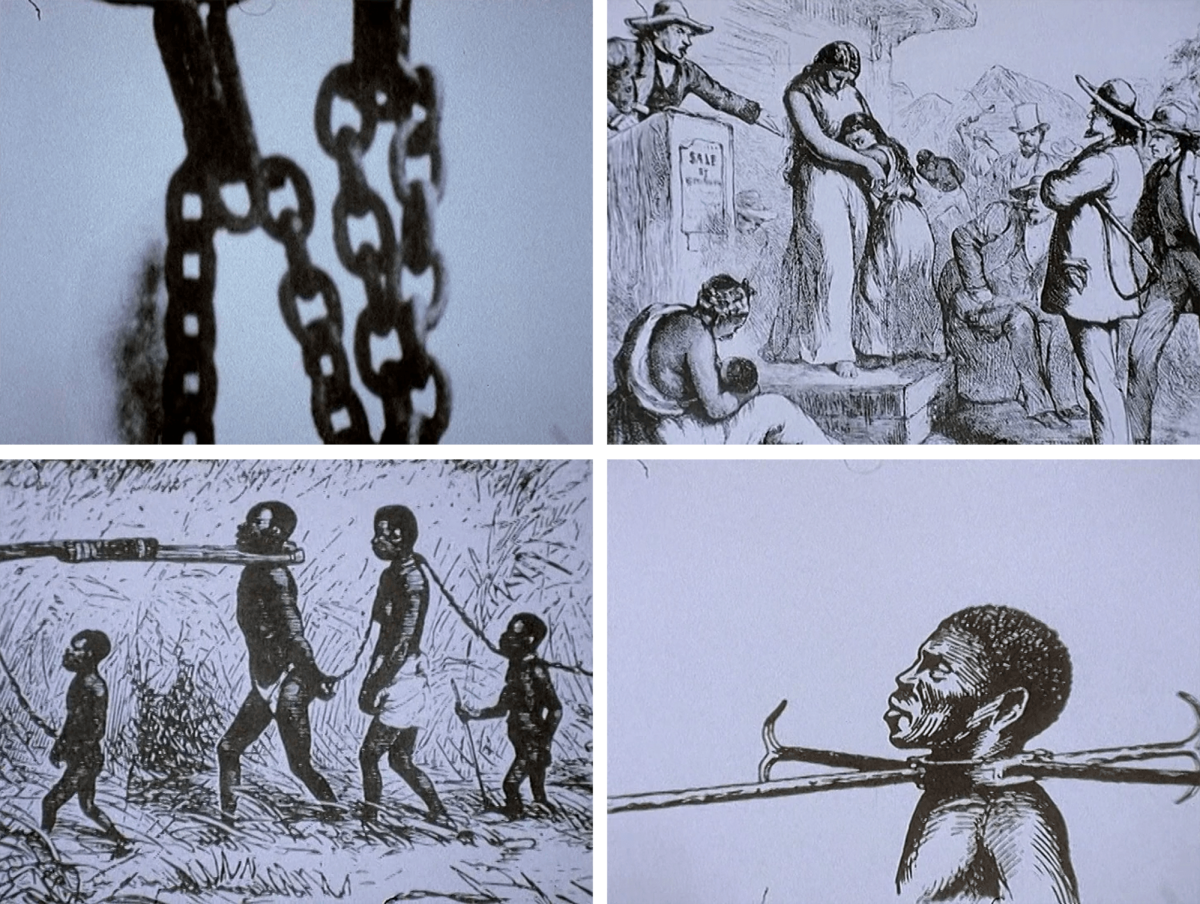
Bodies on the Edge
If we go even further back in Kramer’s oeuvre, we see that the actor who describes the river in Ice plays a similar role as a nomadic revolutionary organizer in The Edge (1967). In a conversation, he evokes the brittle structure of the (fictional) revolutionary movement that he is part of and in which the relations between personal and collective spaces are constantly shifting.
“I've been thinking about all these people. We’re getting to this point where we’re going to have to go in different directions. [...] I’ve been running around a lot talking with all these people about their different plans and projects and stuff, and that leaves me up in the air, because I’m not thinking about any particular thing like ‘what am I going to do,’ you know, ‘to end the war,’ ‘where am I going to put my body,’ ‘what would be really useful,’ you know?”
Where am I going to put my body? The question casts a shadow over the slowed-down, branched-off realities in Milestones. The bodies that no longer find a place in the service of the revolution or the ending of the war are now directing the revolution (or the war) at themselves and the bodies around them. The film’s leitmotif is to be found in the constant negotiation between the personal and the political. We see the characters searching for new forms of coexistence, alternative ways of raising their children, a new physicality, sexuality, love. The baby boomers have turned thirty, and for many of them a time has come in which the meaning of an individual life gains the upper hand over collective political projects. If Milestones is still relevant today, it’s because it captures this shift, not just as a cinephile curiosity. The political horizon spelling out the overthrow of capitalism and the possibility of a different social order disappears from sight. Instead, the kaleidoscopic firmament of the individual’s revolutionary potential puts itself forward. Until then, they could have been considered two intertwined undercurrents of one and the same river. The emancipatory slogan from the sixties “the personal is political” now seems to be amended: “Only the personal is political.”
This shift would soon mark a defeat with consequences that still determine today’s political debate. In the spring of 2019, the philosopher Slavoj Žižek described the identity politics that dominate our political horizon as “hypermoralisation, which is a silent admission of defeat.”4 In order not to address the elephant in the room, we settle for the other, no less dire flaws of the room. Whereas we no longer know – and others pretend not to know – that those flaws point to the elephant. Even though the specter of defeatism haunts Milestones, the characters don’t try to avert it through moralization. There is still hope, there is still resistance to the amendment, to the “only,” to the “personal as the political,” as a critic then wrote about the film.5 In this they nevertheless seem dependent on the very countercultural elements that, despite their revolutionary and emancipatory potential, are considered harmless or marketable enough by the triumphant capitalist system and can therefore be disregarded or hedged in and instrumentalized.
Prematurely Aged Languages
The political activity typical of the 1960s was a young anachronism ten years later. One of the characters is a stubborn unionist in Detroit, who stays where he has been for ten years, a worker among workers. He spends his anachronism in the vainly cherished hope of a restart to his struggle, despite a declining degree of unionization and activism among workers as a result of successful divide-and-rule tactics by employers. Stripped of their subversiveness, the specific interpretations of “the personal” in this film already look anachronistic. The communes’ naked bodies, the acupuncture needles and the blind potter’s gestures no longer seem to be grammatically connected and feel like rogue elements of a prematurely aged counterculture that has been downgraded to meditative activity. As a separate side stream, the personal emancipatory discourse seems to be losing its clout. Both the struggle at the heart of the system and the withdrawn self-sufficiency/-fulfillment are losing their subversive impact. The characters themselves seem well aware that they are caught off guard by history – or rather, that they are picked up again after being under the illusion that they had freed themselves from its course. Milestones is the shaping of that awareness.
To this new reality, the prematurely aged vocabularies of counterculture and the New Left are like water off a duck’s back. We see people learning how to speak, see and live again. We go from one conversation to another. Everything needs to be reconsidered and rediscussed. The words explore the growing distance between friends – like spoken milestones for not losing the ever-expanding way between them, Tom-Thumb crumbs, a spoken map casting a kind of spell on cinematic space.
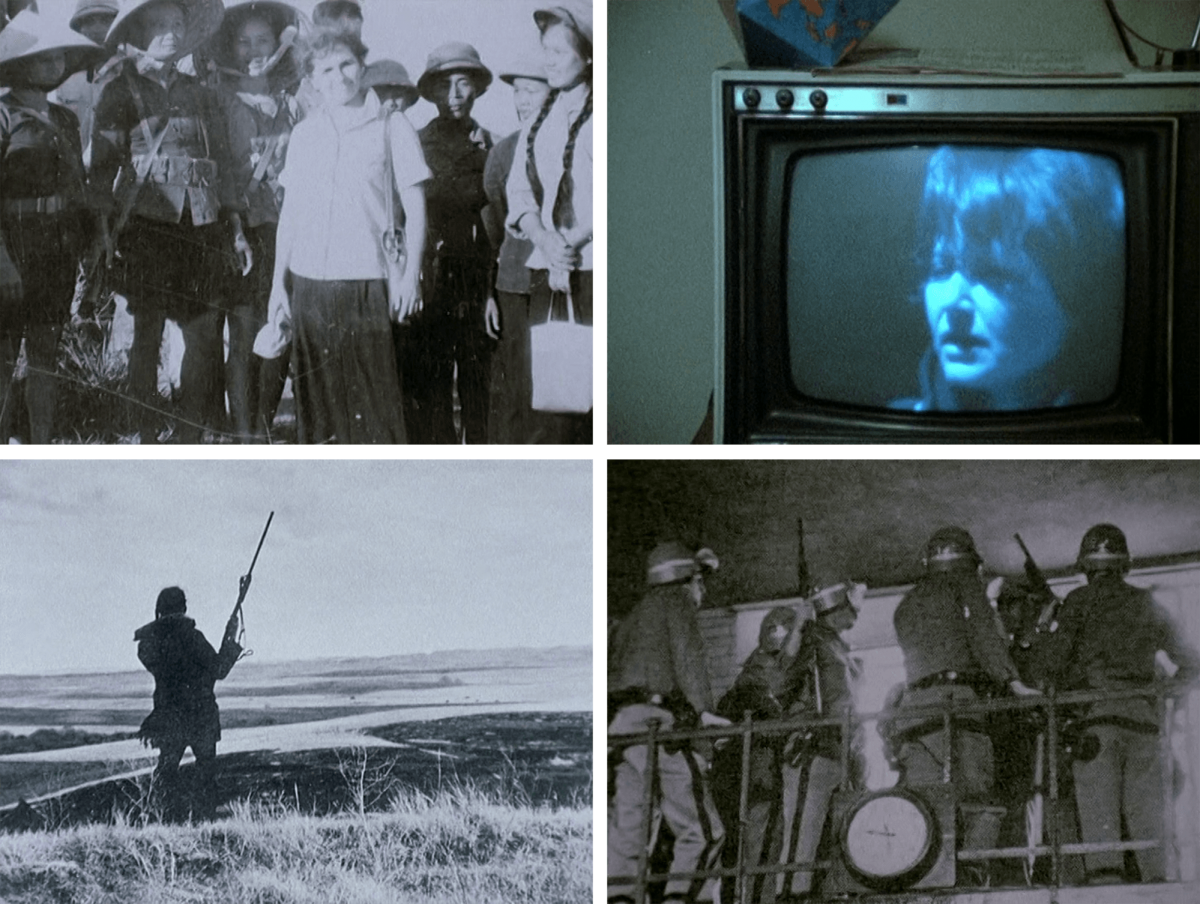
A Frame Around My Life
Despite the apparent impossibility of a collective political horizon, Milestones attempts to say “we” again by historicizing the word. The history of slavery, the systemic oppression and resistance of the black population in the US, the genocide against indigenous peoples and their resistance, and the immigration from Europe all form counterpoints in the fabric of fragmentary scenes and its nomadic characters; always in medias res, and without establishment-shot, show-the-world, or character-sketch ceremony. We never know where we are exactly, who we see and hear or how they are connected. The film literally begins in the middle of a sentence
– ...and it's in his dialect from Calabria... –
before a daughter sings her father’s song and we follow her mother on her way to work through the city rain. As she tells her story, we cut to pictures of the New York of her youth at the beginning of the twentieth century. Then we see mother and daughter talking to a young woman who is part of the film crew. The motifs of the montage have been introduced within the first minute of the film – no wild river, but a multi-armed delta stretching across American history and landscapes. They talk about the special bond between mother and daughter. It’s something the young woman of the film crew can only dream of. The old woman asks the young woman if her mother is still alive. She says yes, hesitantly. “But I don't know if that will ever break through. It will break through with me to other people, I think, rather than back into my history with her.”
The genealogy represented in Milestones rises above bloodlines, stretches across multiple family-tree trunks. Detaching and attaching. Spilling crumbs, we keep going back and forth between the “we” – the tribe of which the film is weaving the creation myths and prophecies.
“We” does not shy away from itself. It wants to know where “we” comes from and what that word excludes. Kramer and Douglas try to portray racism as the foundation of American capitalist hegemony in various ways. Rather than restore the histories of those who lost their American dreams, they use their images to produce a kind of new shared history. There’s a tremendous amount of talking in Milestones, but for some things “we” lack words. We are shown archival footage of rebellious, chained, lynched, killed enslaved people, while the soundtrack is silent. Even today, writers and artists go back to the traumatic roots of the ghettoization of American society, the segregation at the heart of its structure that is still driving it. The silence that in Milestones accompanies as a kind of deficit the sight of these horrible images, conjures up a different silence, which doesn’t accompany the images of horror but belongs to the horror in the image. While image and silence belong to two irrevocably separated spaces in Kramer’s film – a commemorative silence – the wretched silence kept by the protagonist of a contemporary historical novel forms the center of its narrative space. Cora, the escaped slave from Colson Whitehead’s The Underground Railroad (2016), runs for her life. As she hides in the attic of a white abolitionist on her way to slavery-free North Carolina, she peeks at the terrible spectacle of daily lynching in the village square through a tiny hole in the wall and has to lay low in the lion’s den in silence for weeks, observing the horrible frenzy over and over again.
“[...] the night riders dragged the girl to the great oak in the middle of the park. Cora had seen the wheeled platform in the corner of the park that day; children climbed and jumped on it all afternoon. At some point in the evening it had been pushed beneath the oak tree. (...) people of all ages rushed to their places on either side of the platform. The noose lowered around Louisa’s neck and she was led up the stairs. With the precision born of practice, a night rider threw the rope over the thick, sturdy branch with a single toss. One of those who had gathered to push the ramps away was ejected – he’d already taken his turn at a previous festival. A young brunette in a pink polka-dot dress rushed to take his place.”6
In a dream of one of the Milestones characters, the African-American abolitionist Harriet Tubman appears, a central figure within the network known as “the underground railroad”, which helped escaped slaves flee to the North.7 When he talks about his dream and about the book he read about her, the camera travels over a wooded hilly landscape, and we hear him say: “She sort of put a frame around my life.” The past offers frames, not to look at, but to look from at reality in motion. In Milestones, that reality is dominated by the spinning relationship between intimate personal space and collective political space. It is the very absence of a collective political project that stands in the way of real self-development for some. For others, that self-development is political in itself. Kramer and Douglas draw lines across the landscapes and history of the US in order to map out that oscillating relationship. History strings the film, the tuning and playing occur simultaneously. What follows is a variation on the montage’s weaving theme much in the same way that improvising musicians handle a phrase. The construction of the film is related to the construction of a history, a network of milestones for orientation. There is a constant search for other angles, as you can’t see the dust in your room dancing in the sunlight until you look at it from a certain angle. Within the film fabric, numerous visible, imaginary, and sometimes opposing networks, structures, and lines unfold: the underground railroad, a thousand-year-old Iroquois family line,8 mother-daughter and father-son links, the rhizome of revolutionary cells, looms, highways, frontiers, chain gangs, mile-long Viet Cong tunnels,9 entire chains of people like a mighty river,... The color landscapes – deserts, forests, farms – call to mind the vast America of Technicolor westerns. The cities appear as a chain of rooms, bars, and workshops. And although it is clear that these are “documentary” rooms where people are really living, they might just as well exist side by side in a film studio. Although Kramer and Douglas never make direct references, film history impregnates the way we view the film’s landscapes and cities because we have seen them so often, both before and after Milestones. That is why the two most clearly fictional scenes are precisely the moments when reality appears. One of the characters narrowly escapes an assault, while another dies in a burglary. The fiction amplifies the signal of what they are trying to say in reality; in the words of a young unemployed mother in the film: “America is killing me.”
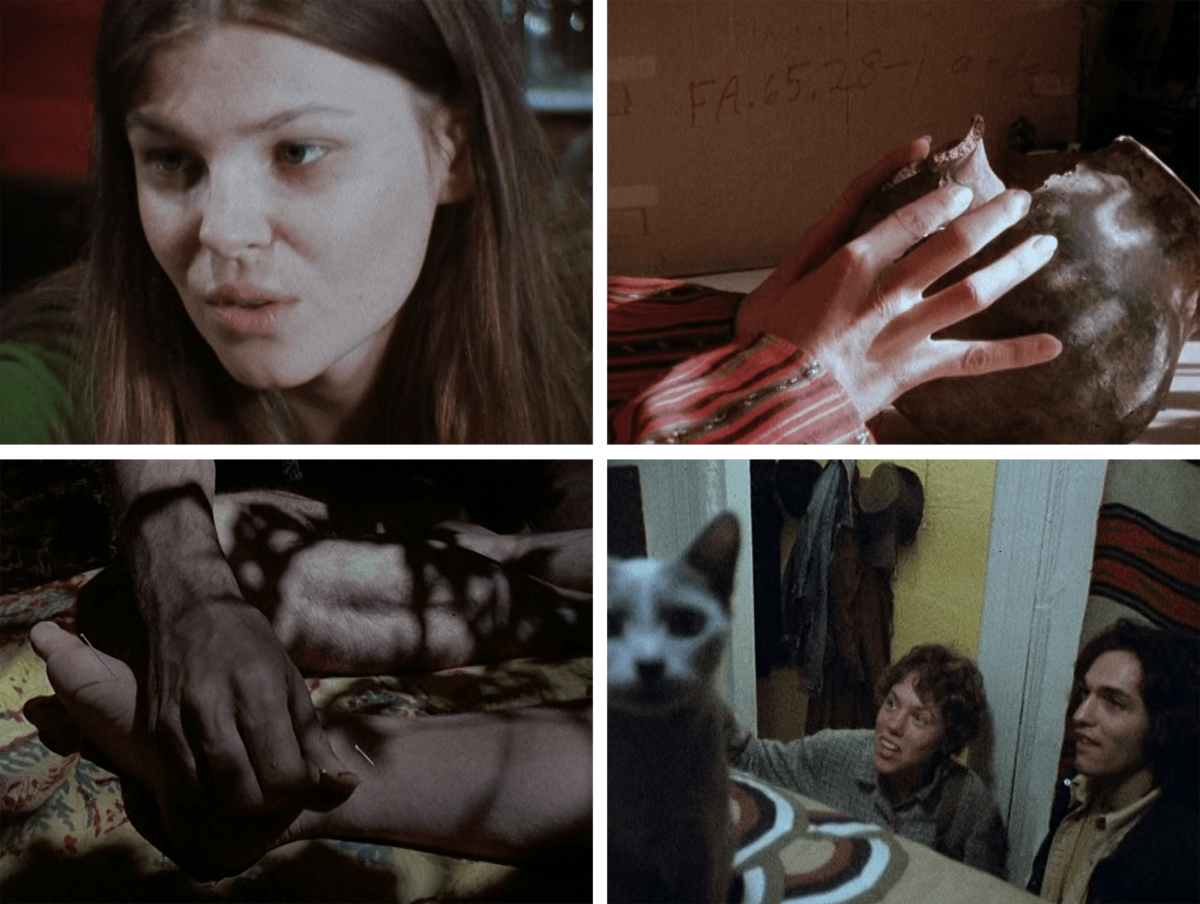
“Romantic can mean one or two things”
At the beginning of the film, a young woman sits at an editing table that shows images of the Vietnam War. They were made by Helen, the older woman standing next to her, an American who worked for the enemy during the war. We see fragments of the collective struggle of the North Vietnamese. The image flows. The image freezes. People work together. The montage becomes a chain of gestures, uniting many bodies into one, like one hand naturally helping the other into a glove. There are no questions about what needs to be done. The urgency connects, speaks for itself.
Milestones was shot and takes place at a time when the war is practically over, after the American disengagement. The footage in the film has already become historical footage. It is no longer part of the acute political struggle.10 The footage no longer serves to help win the war but rather to help serve the winning of the war. It is about producing a history that is already a peerless, defenseless counter-history. A lasting victory demands a lasting effort. The film and sound footage the young woman is watching is the still shapeless appearance of the history of the true, unexpected winner – the collective. It must arm itself against the stories of the loser – the empire, which now applies its cultural hegemony to produce its own version of the recent past. The desired amnesia/amnesty demands constant PR, which drowns the catastrophe of losing in the pathos of individual heroics, the trauma and pathology of the war veteran. The liability of the state is spirited away by the thousand-yard stare of a shell-shocked marine.11 Once out in the world, the image becomes a defenseless mercenary. Faced with this manipulation or rewriting of the past, both Helen and Robert Kramer try to bring a new form to bear: their own continuous rewriting. Which is not only about rehabilitating lost histories but also about producing new ones. More than revelation, accusation, or détournement, the filmmaker’s task is the production of a form that does not merely react but tries to speak its own language.
Not until Helen’s footage acquires a form will it be able to compete against this concealment-cum-amnesia. The editing table connects the urgency within the footage with the patience and concentration needed to create a film form. The editing table as a history machine. The stakes are high. That is what Helen is struggling with throughout the film. She was really there – as proven by an unmistakably documentary photograph of her posing with Viet Cong fighters – but she is also a form. Her struggle, of which we only see and hear fragments, echoes Kramer’s own search for a new form, for a new cinematographic relation to reality – and to time, the experience of which is no longer characterized by the immediacy and collective energy of wartime. Kramer turns his fellow travelers and himself into a form in order to produce a new starting point. The film becomes the story of producing a new fiction, however steeped in disillusionment with the failed collective project.
The young woman looks at Helen and speaks with a kind of desperate admiration, the downside of a different feeling: frustration about her own inability to do something with her life, to find a useful place for her own body. For those who are at more or less socially acceptable variance with the way of world, this must be a familiar emotion. Like her, we arrived on the scene too late, a scene that is becoming increasingly depoliticized, punctuated with the sickening refrain that the emergence of something new has become impossible. Somewhere between “there is nothing new under the sun” and “resistance is futile.” The assistant editor struggles with other demons, which Helen seems to have defeated already – how to live a meaningful life despite it all. As with the editing of a film, the difficulty of that task is to be found in the thoughtful shaping of footage that presents itself as both urgent and always in motion. The pressing appeal seduces us into rash action. The filmmaker contrasts this with a thinking in motion. Watching the frozen image of a group of Viet Cong fighters on the editing table, the two women have a conversation:
“She’s living her life, and these people are into their lives and I’m really beginning to wonder where my life is at. Helen, you’re always telling me stories. You told me that story of walking along the path in the Vietnamese village and you had to stay on the path because there were unexploded bombs, and you know, I really think about what it’s like to be in a village, in any village, much less a village where the bombs are about to explode.”
“You have to find a way to show that... Last year, when I was in that country, there were terrible floods, they were awful, terrible, farms were wiped out for miles, and people had to work together, they had to, and they did. They had to build dikes, they had to find blankets, they had to feed people. Men and women and kids did that, old people, the big shots and the little dirt farmer, everyone. No one asked you who you were. It was great. It was like home for me. We ate together, we liked each other... At that time, I had a lot of trouble in my life. I was having a lot of problems. I stopped thinking about them. I stopped thinking about myself. I think it was like that for everybody. I think that that’s what we brought back from Vietnam. It’s funny, I’ve given you two examples and they’re both disasters. Do we need disasters for people to come together?”
“But the thing about you and disasters is, you tell these stories and they don’t sound like disasters at all, they really sound very romantic!”
“Okay, romantic! They’re romantic, fine. Okay. Romantic can mean one or two things. It can mean ‘silly,’ or it can mean ‘hopeful’ and I say it means ‘hopeful,’ okay!?”
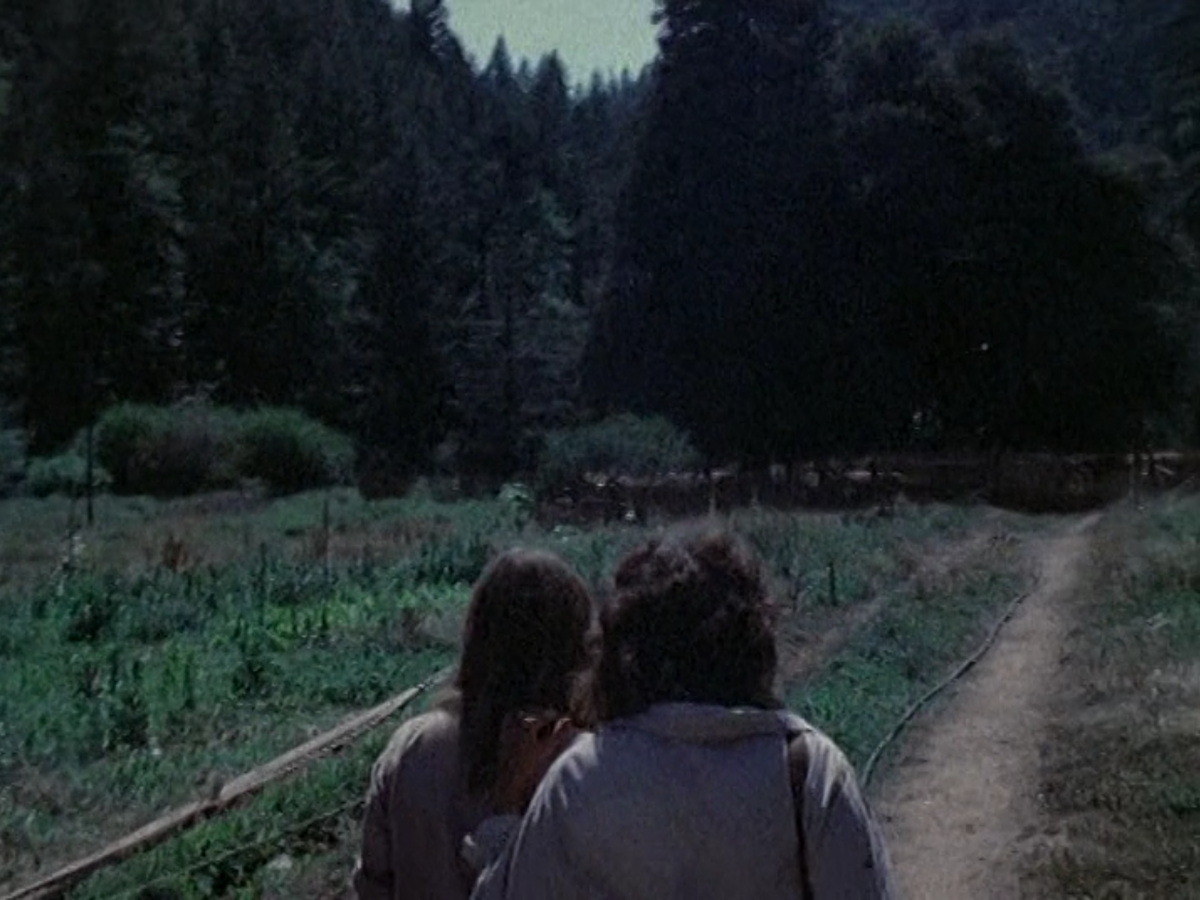
The Benefit of Hindsight
A romantic reading of Milestones, or what it can mean as a historical document, cuts both ways. Naive-lucid romanticism keeps moving (think Sturm und Drang), is active, and takes risks for real stakes. That’s the romanticism that is despite it all still trying to shape the world. And if it cannot change reality itself, it can at least change the form in which it presents itself to us. Today, a different – silly – kind of romanticism plays a game of neither risks nor stakes. Melancholy thrives in the format that commemorates our parents and grandparents as sympathetic revolutionaries, and we practice this “alasness” conspicuously. The revolutionary melancholy at the heart of this romanticism degenerates into an aesthetic experience, a nostalgia for colors, clothing styles, attitudes, behavior. The revolution becomes a costume party. But melancholy and desperation aren’t the only codes by which to read the past shown in Milestones.
Does that mean that the benefit of hindsight is the upside of our sad lateness? The possibility of a historical looking back, the analysis of which could teach us something? Can the past offer us the material to reposition ourselves, to try to understand some of the dynamics that were opaque to those who were in the middle of it? To trace the outlines of our own middle? Do they form a frame for our gaze, as Harriet Tubman’s spirit put a frame around the life of one of the characters? Less commemorative silences, more frames? Not less but more form? The images of the past, like those of Milestones today, always land right in the middle of the gaze of contemporary observers/creators. History takes place in medias res. The production of a film becomes the production of history.
Although there seems to be no shortage of diagnoses of the current political deadlocks, we still don’t know what to do. And if we do, it is said that there is no basis. Cinema is no longer a political weapon in the way of Kramer and the Newsreel collective. The seventies marked a worldwide turning point for militant filmmakers. The French philosopher Jacques Rancière writes: “The images of art do not supply weapons for battles. They help sketch new configurations of what can be seen, what can be said and what can be thought and, consequently, a new landscape of the possible.”12 If Milestones is still interesting today, beyond its political dimension, it is because the film still nurses the hope that cinema is meaningful and, as a layman, from a certain naivety – or from the hope we now know to be vain – still dares to historicize, to think in motion, to draw lines, to give form to a fluid reality. With that “forming” naivety, filmmakers – who know a little bit about many things and very little about a lot of things – could overcome their reluctance to point the camera at the world. Thus, they are hopeful after all, and anything but silly. Cinema can only weave an inadequate fabric, but reality occasionally surfaces when stitches are dropped. For the illusion of movement to reach the screen, the light of the projector must be interrupted twenty-four times per second by the opaque shutter. In order for real things to be shown or said, reality must appear as a form. In order for history to help us today, it must emerge from its own representation time and again, like Robert Kramer’s and John Douglas’s tribe.
I think this is the last film.
Everything has to be in it. Nothing left out
because of “considerations.”
All the play of the heart.
All the fullness of feeling.
The form will make itself passionately.
Last movie, in which the form evaporates into life.
Common denominator of choices:
getting down to bone.
Essence. Desert – mountain – people –
food – motion.
Stripped away.13
- 1Serge Daney, “The Aquarium (Milestones)”, in: Cahiers du cinéma: Volume Four, 1973–1978: History, Ideology, Cultural Struggle: An Anthology from Cahiers du cinéma, 248-292, September 1973–September 1978 (London: Routledge, 2000).
- 2G. Roy Levin, “Robert Kramer and John Douglas interviewed. ‘Reclaiming our past, reclaiming our beginning’”, Jump Cut, no. 10-11 (1976): 6-8. Kramer illustrates this sensation by means of an anecdote: “There’s a wonderful thing in a book on Cuba, an argument very early in the revolution because America had withdrawn all of the glass producing materials, about what should Cuban glass look like. The first thing they came up with were all kinds of pissy yellow, and it was one position in the Central Committee – it became a Central Committee issue – that that was fine because there were a lot of other things that had to be done. But Che took the position that revolution is not about ugliness and they carried on through – it was a specific technological problem – until they had finally produced a kind of glass that didn't turn everything into this milky, unappetizing sort of thing.”
- 3Serge Daney, “The Aquarium (Milestones)”, in: Cahiers du cinéma: Volume Four, 1973–1978: History, Ideology, Cultural Struggle: An Anthology from Cahiers du cinéma, 248-292, September 1973–September 1978 (London: Routledge, 2000).
- 4“Happiness: Capitalism vs. Marxism” was a debate between psychologist Jordan Peterson and philosopher Slavoj Žižek on the relationship between Marxism, capitalism and happiness. It took place on 19 April 2019 in Toronto, Canada.
- 5Michelle Citron, Chuck Kleinhans & Julia Lesage, “White punks on revolution in Milestones”, Jump Cut, no. 10-11 (1976): 8-9.
- 6Colson Whitehead, The Underground Railroad (New York: Anchor Books, 2016), 160.
- 7Harriet Tubman (Dorchester County, Maryland, 1823 – 10 March 1913) was an African-American abolitionist. Born into slavery, she escaped and subsequently made some thirteen missions to rescue approximately seventy enslaved people, using the network known as the Underground Railroad. She helped John Brown recruit supporters for his 1859 raid on Harpers Ferry, a failed attempt to start a slave rebellion by raiding the arsenal at Harpers Ferry (West Virginia). During the American Civil War, Tubman worked for the Union Army, first as a cook and nurse, and then as an armed scout and spy. She guided the raid at Combahee Ferry, in which more than seven hundred enslaved people were liberated by the Northern Army, and worked for Colonel Robert Gould Shaw during the doomed attack on Fort Wagner. After the war, she retired to the family home in Auburn, New York, where she cared for her aging parents (whom she had helped escape from the South before the war). Later in life she was active in the women’s suffrage movement. (Wikipedia)
- 8While a group of activists is selecting and projecting slides about the Iroquois reserve they are staying at, we hear an Iroquois tribal chief speak off-screen: “Sovereignty, in its simplest explanation is freedom. And so we have the Oglala Sioux who should be conducting their affairs here. But now whose government is interfered with. And this is what you’d call a violation of sovereignty. I am Umwehue. I am Haudenosaunee. I come from Onöñda’gaga’, the capital of the Iroqois. And I have an ancestry that goes back beyond a thousand years in one place, in the same place. Of course, we’re sovereign, and of course we are these people, and have been longer than almost anybody else in this whole world.”
- 9There’s a funny remark about these tunnels in Starting Place (1994), a film essay in which Kramer goes back to Vietnam and tests his experience during the war against the way the country is “now” dealing with the past. Twenty years after the war, the tunnels have become very important for war tourism, to the extent that they have been extended and widened to make room for public toilets.
- 10In reality, the images are from The People’s War (1969), the film Kramer made together with other Newsreel members. It was made and shown during the war and was therefore meant to show the other side, to serve as counterpropaganda. The fact that the footage returns in Milestones five years later, sets an implicit self-historicizing tone.
- 11The British author John Berger points to the ambiguity of shocking images – such as war photographer Don McCullin’s “Shell Shocked Marine” from 1968, a photograph that tipped public support for the Vietnam War: “The possible contradictions of the war photograph now become apparent. It is generally assumed that its purpose is to awaken concern. The most extreme examples – as in most of McCullin’s work – show moments of agony in order to extort the maximum concern. Such moments, whether photographed or not, are discontinuous with all other moments. They exist by themselves. But the reader who has been arrested by the photograph may tend to feel this discontinuity as his own personal moral inadequacy. And as soon as this happens even his sense of shock is dispersed: his own moral inadequacy may now shock him as much as the crimes being committed in the war. Either he shrugs off this sense of inadequacy as being only too familiar, or else he thinks of performing a kind of penance - of which the purest example would be to make a contributionto OXFAM or to UNICEF.” (John Berger, “Photographs of Agony”, in: John Berger, Geoff Dyer (ed.), Understanding a Photograph (London: Penguin, 2013).
- 12Jacques Rancière, The Emancipated Spectator (London-New York: Verso, 2009), 103.
- 13Robert Kramer, “Note about the Movie”, 1973 (press kit Milestones).
Images from Milestones (John Douglas & Robert Kramer, 1975)
With thanks to Liesbeth Beeckman, Gerard-Jan Claes, Nina de Vroome and Sis Matthé.
Hannes Verhoustraete is associated with KASK School of Arts in Ghent as a researcher.

